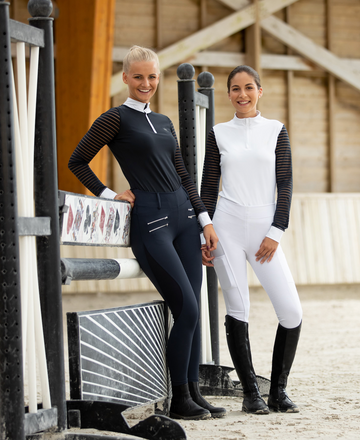Breeches or Tights: Which is Right for You?
While horseback riding has a reputation for being traditional, modern riding tights and breeches are anything but old-fashioned. Both come in more colors, fabrics and styles than ever before, and it can be hard to tell the difference, never mind to pick the right ones for you.
What’s the difference between breeches and tights? What about silicone, leather, or faux leather patches? What’s two-way and four-way stretch? Doesn’t anyone just wear jeans anymore?
To help you choose the best breeches or tights for you, we’ll demystify the differences and examine the options available. When it comes to riding apparel, the “best” choice is what best meets your needs.
First thing’s first, let’s define breeches and tights. As textile technology develops, one is looking more and more like the other! But there are a few key differences.
Breeches
Breeches were initially part of the cavalry uniform and made of heavy twill, a durable fabric that is hard to tear and hides stains well. It’s also not very comfortable, doesn’t breathe, and has almost zero stretch.
Early breeches featured leather reinforced patches on the inner knee to prevent wear after long hours in the saddle. These patches were real leather, bulky, and didn’t stretch much.
Fast forward a hundred years, and even the worst modern breeches are more comfortable than early ones. While a lot has changed, a few things remain the same: Breeches are still made of thick, sturdy fabric suitable for long hours in the saddle. They usually feature a zip fly, although many designers experiment with mock flies (called pull-on breeches) and side zips. While breeches may have pockets, they’re typically small and not always very functional.
Breeches, like tights, come in both knee patch and full seat options. Knee patches are a favorite of the hunter/jumper world, whereas eventers and dressage riders usually opt for the security of a full seat.

Breeches are a classic and are appropriate for anything in the saddle, from a casual trail ride to lessons or shows.
If you plan to show, you’ll need breeches. A light beige pair can readily handle lessons and lower level schooling shows, but if you plan to specialize, you may need a specific style, depending on your discipline.
Read here to find out which style of breeches is right for your discipline.
While they’re great for riding, breeches aren’t the best choice if your day at the barn involves mucking stalls or moving hay. Lighter colors don’t handle dirt well (though just about every manufacturer makes black breeches, too). Most need special washing, or at least line drying. And unless you’re going for “the equestrian look,” it can feel a little awkward running post-ride errands in breeches.
Riding Tights
While fairly new to the riding scene, tights are growing wildly in popularity. And with good reason – tights are more about function (and fashion) than breeches.

Riding tights are styled after your favorite yoga pants, and feature some of the newest and most advanced technical fabrics on the market. These stretchy fabrics are very flexible and comfortable, but also breathe exceptionally well, keeping you cool while you ride. Just like breeches, tights come in knee patch and full seat options.
While breeches don’t usually come in colors more avant-garde than olive green or black, tights aren’t bound by the same tradition. If you want to stand out, riding tights are for you! They come in a wide array of colors and prints. While you can find traditional white or beige riding tights, you can also get anything from blue to neon or leopard print.
Many designers also feature figure-flattering piping, contrasting panels, or other design features. Tights are also more likely to have modern conveniences, like cell phone pockets and functional zip pockets for your keys.
The most significant selling point to tights, aside from the fashion factor, is unmatched stretch and comfort. The thin fabric provides a closer contact feeling, and breathes much better in warm weather. Don’t worry, tights come in cozy winter varieties, as well.

While there are some ridiculously comfortable breeches out there, tights typically feature lighter, thinner fabrics with more stretch. Let’s take a quick minute to talk about stretch fabric, and what this means for your ride:
All About Stretch
Almost all tights are made with 4-way stretch fabrics, whereas breeches come in 2- and 4-way options.
Stretch fibers like Lycra and Spandex are interwoven with solid fabrics, like cotton, polyester, and bamboo in different proportions to create different amounts of stretch.
4-way stretch fabrics are unmatched in terms of flexibility. 4-way expands in two directions, vertically and horizontally. While they have a lot of give, these fabrics don’t hold much shape of their own.
2-way stretch fabrics also contain some percentage of stretchy fabric, but they only expand in one direction. They’ll stretch either horizontally or vertically, but not both ways.
While 2-way stretch blends don’t offer as much ‘give’ as 4-way stretch, they do hold their shape well and stand up to the rigors of regular wear and washing better. If you’re looking for a thicker, more sturdy pair of breeches, ones made with 2-way stretch fabrics are a good choice.
Knee Patches & Full Seats
Most synthetic leathers used in knee and seat patches, such as ALOS or Clarino, offer surprising stretch and softness, and require very little special care (generally not a good idea to put them in the dryer, though).
A huge trend in both breeches and tights is silicone knee and seat patches. Instead of sewn-in synthetic leather patches, manufacturers are melding a tough, yet super flexible silicone directly onto the fabric. The silicone-covered fabric is much lighter than traditional leather patches and reduces or eliminates thick seams.
Silicone patches can get pretty stylish too, as manufacturers can produce almost any shape, from a snaffle bit print to spots, stripes and even lettering. It can also be dyed nearly every color (and yes, glitter too!). Since the silicone is designed for use in the saddle, it won’t damage your tack, either.
Some riders swear by silicone seats, but others find them a little too sticky for their liking, depending on the activity.
Other Options
Seasonal Legwear
Don’t overlook seasonal concerns, either. Both tights and breeches come in summer and winter varieties, which can be a necessity depending on where you live.
Summer breeches are made in lighter weight fabrics and may feature panels made of extra-light material to help you stay cool. Summer tights will keep you coolest, thanks to the already thin fabric.
Winter breeches use heavier fabrics to trap heat closer to your body, and many winter tights are fleece-lined, making them warm and cozy. If you plan to ride outside during the winter, opt for a synthetic mixed fabric that sheds moisture better than cotton. Or try winter riding pants!

Winter riding pants are an excellent option for trail riders or people living in cold northern climates. Unlike breeches, these feature a robust outer shell, insulation fill, and a soft inner lining, just like a parka or your horse’s winter blanket. They feature a higher rise to keep your lower back warm, plus some models have suspenders to keep them snug. While they look like ski pants on the outside, they also feature a full seat or knee patches for security in the saddle.
Jeans
Cowboys wear jeans for a reason: they’re hard-wearing, easy to come by, and stand up to barn work and hours in the saddle. They’re easy to fit under chaps and half chaps (especially skinny jeans), can be pretty stretchy (looking at you, jeggings) and don’t necessitate a costume change before or after riding.
If you’re not doing barn work or riding through rough terrain, though, you may find breeches or tights a more comfortable choice. Thick inseams on jeans can rub and irritate your inner thighs, they tend to “gap” at the back and bunch up at the knees and hips, and denim has very little grip in the saddle.
If you like the look of classic denim though, you’re in luck. Manufacturers are coming out with street smart denim breeches that combine the classic look of your favorite blue jeans, with the features you need as an equestrian like knee patches, full seats, a higher rise, and wider waistbands.

What is Right for Me?
Like most things, the answer comes down to what works best for you.
If you’re showing, you won’t have much choice, unless you’re choosing between beige or white.
Lesson students, casual riders, and eventers can use whatever options suit their taste and color scheme.
For kids’ camps, tights are more comfortable and easier to keep clean than breeches, while still allowing the right functionality for anything they’d want to do in the saddle.
If you’re in lessons but gearing up for show season, it’s wise to train in something similar to what you’ll be showing in. You don’t want to wait till your first fence to discover that silicone full seat breeches aren’t right for you!
If your day at the barn involves mucking, grooming, bathing or clipping, tights or even jeans with chaps, may be the right choice for you.
The only way to know for sure is to experiment. Try a few different options and see what works for you! And if you need help with sizing, read this helpful guide.


